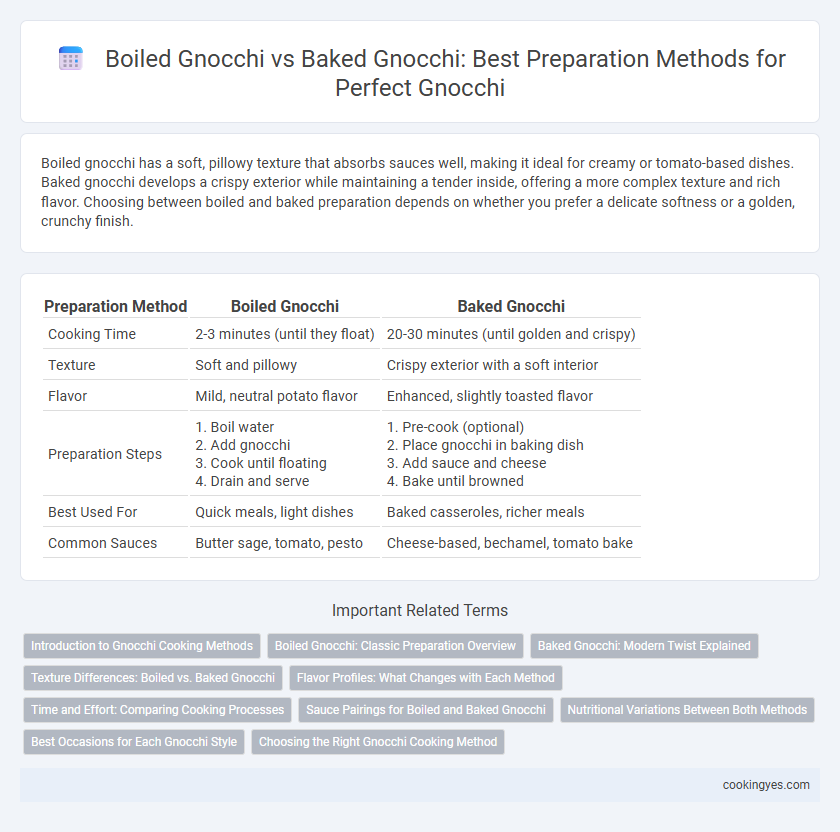Boiled gnocchi has a soft, pillowy texture that absorbs sauces well, making it ideal for creamy or tomato-based dishes. Baked gnocchi develops a crispy exterior while maintaining a tender inside, offering a more complex texture and rich flavor. Choosing between boiled and baked preparation depends on whether you prefer a delicate softness or a golden, crunchy finish.
Table of Comparison
| Preparation Method | Boiled Gnocchi | Baked Gnocchi |
|---|---|---|
| Cooking Time | 2-3 minutes (until they float) | 20-30 minutes (until golden and crispy) |
| Texture | Soft and pillowy | Crispy exterior with a soft interior |
| Flavor | Mild, neutral potato flavor | Enhanced, slightly toasted flavor |
| Preparation Steps | 1. Boil water 2. Add gnocchi 3. Cook until floating 4. Drain and serve |
1. Pre-cook (optional) 2. Place gnocchi in baking dish 3. Add sauce and cheese 4. Bake until browned |
| Best Used For | Quick meals, light dishes | Baked casseroles, richer meals |
| Common Sauces | Butter sage, tomato, pesto | Cheese-based, bechamel, tomato bake |
Introduction to Gnocchi Cooking Methods
Boiled gnocchi involves cooking the soft potato dumplings in salted boiling water until they float, resulting in a tender and pillowy texture that absorbs sauces well. Baked gnocchi, on the other hand, is typically tossed with sauce and cheese before being baked, creating a crispy exterior while maintaining a soft interior. Choosing between boiling or baking affects the overall texture and flavor profile, making gnocchi preparation versatile for different culinary preferences.
Boiled Gnocchi: Classic Preparation Overview
Boiled gnocchi is the classic preparation method involving cooking the dough pillows in salted boiling water until they float, signaling they are done. This technique ensures a soft, pillowy texture with a delicate bite, making it ideal for absorbing sauces like marinara or pesto. Boiling preserves the lightness and moisture of the potato-based gnocchi, contrasting with the denser texture of baked variations.
Baked Gnocchi: Modern Twist Explained
Baked gnocchi offers a modern twist by creating a crispy, golden crust while maintaining a soft interior, enhancing the texture compared to traditional boiled gnocchi. This preparation method allows for layering with sauces and cheese, resulting in a richer, more flavorful dish. Baked gnocchi is ideal for recipes seeking a hearty, gratin-like finish, providing both visual appeal and complex taste.
Texture Differences: Boiled vs. Baked Gnocchi
Boiled gnocchi has a soft, pillowy texture with a tender interior and a slight chew, making it ideal for absorbing sauces. Baked gnocchi develops a crispy, golden crust while maintaining a fluffy center, offering a contrast in textures. The choice between boiled and baked gnocchi depends on whether a smooth, delicate bite or a crunchy exterior with a soft middle is preferred.
Flavor Profiles: What Changes with Each Method
Boiled gnocchi retains a soft, pillowy texture with a mild, subtly sweet flavor that highlights the natural potato taste. Baked gnocchi develops a crisp, golden exterior while intensifying savory notes through caramelization, often absorbing richer flavors from accompanying sauces and cheese. Choosing between boiling and baking significantly influences the overall sensory experience and flavor complexity of the dish.
Time and Effort: Comparing Cooking Processes
Boiled gnocchi cooks quickly, usually in 2-3 minutes once they float to the surface, requiring minimal active effort and constant attention. Baked gnocchi demands additional preparation time, including boiling beforehand and then baking for 20-30 minutes to achieve a crispy texture, increasing overall cooking duration and effort. The boiling method is faster and simpler, while baking offers enhanced flavor and texture at the cost of more time and steps.
Sauce Pairings for Boiled and Baked Gnocchi
Boiled gnocchi offers a soft, pillowy texture that absorbs light sauces like sage butter, pesto, or simple tomato sauce, enhancing subtle herb and cheese flavors. Baked gnocchi develops a crispy exterior ideal for robust, creamy sauces such as bechamel, four-cheese, or meat ragu that complement the golden crust with rich, hearty notes. Choosing the cooking method influences sauce pairing by balancing texture with flavor intensity for an optimized gnocchi dish experience.
Nutritional Variations Between Both Methods
Boiled gnocchi retains more water content, resulting in lower calorie density and reduced fat compared to baked gnocchi, which tends to have a slightly higher caloric value due to caramelization and potential oil absorption. Baked gnocchi often contains increased Maillard reaction compounds, enhancing flavor but also influencing antioxidant levels and nutrient availability. The choice of preparation method affects glycemic index as boiling typically produces a softer texture that may increase carbohydrate absorption speed, whereas baking creates a firmer texture that could slow digestion.
Best Occasions for Each Gnocchi Style
Boiled gnocchi is ideal for quick, everyday meals where a soft, pillowy texture complements light sauces like sage butter or marinara. Baked gnocchi suits cozy gatherings or dinner parties, offering a crispy, golden crust perfect for rich, cheesy gratins or baked casseroles. Choose boiled gnocchi for fast comfort food and baked gnocchi for indulgent, oven-roasted dishes.
Choosing the Right Gnocchi Cooking Method
Boiled gnocchi offers a tender, pillowy texture achieved through quick cooking in salted water, preserving the delicate potato flavor and preventing dryness. Baked gnocchi provides a crispy exterior with a creamy interior by combining boiling with oven baking, ideal for gratin-style dishes that add depth through cheese and herbs. Selecting between boiled or baked gnocchi depends on desired texture and recipe type, with boiled suited for light sauces and baked enhancing rich, hearty preparations.
Boiled gnocchi vs baked gnocchi for preparation Infographic

 cookingyes.com
cookingyes.com